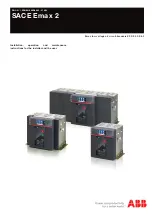
Modes
The Power Probe IIIS has been designed to work the same as the previous Power Probe circuit testers. Using the ad-
vanced features and modes is optional. However, understanding them will expand your diagnosing capabilities. The
LCD display indicates voltage levels of the circuit along with an identifying symbol showing you what mode it is in.
The additional features contain 5 new modes which give you specific information about how the circuit is reacting.
The 5 Modes menu can be accessed by depressing the right Menu button. Then press the left button to select the
needed test mode. Once the desired test mode is highlighted on the menu screen, press the right Mode button to
enter that test mode.
Mode #1 Voltmeter Mode
: While the PP3S is in “Voltmeter Mode” and the probe tip is floating (not contacting a
circuit), the display will show “DC VOLTS.” If the audio tone is turned on you will see a speaker symbol in the lower
part of the display. Once you contact the probe tip to a circuit the LCD display will indicate the average voltage
level of the circuit. The red/green polarity indicator (See section Red/Green Polarity Indicator and Audio Tone) will
respond also, showing whether the circuit is positive or negative. A secondary feature in this mode is the peak to
peak threshold detection and signal monitoring. When contacting a signal generating circuit such as a speaker wire
with audio signals on it, the PP3S detects the peak to peak signals and displays the peak to peak voltage on the
display, the sound of the signals will be monitored and heard through the PP3S speaker. The peak to peak threshold
levels are pre-selected by the operator in “Mode 5”. See Mode #5 for more information on setting threshold levels.
Placing the PP3S probe tip next to a sparkplug wire (NOT probing it directly), allows you to monitor the sound of
the ignition pulses at the same time display a peak to peak reading The PP3S senses the pulses in ignition wires
through capacitive coupling (
DO NOT CONTACT PROBE TIP DIRECTLY TO THE SECONDARY IGNITION CIRCUIT
). By
monitoring each plug wire in this way you can locate missing cylinders.
Mode #2 Peak to Peak Mode
: The Peak to Peak Mode measures the difference between the positive and negative
peak voltage levels over a 1 second period. With this feature you can measure and monitor for example, the diode
rectifier ripple voltage in a charging system while the engine is running. The peak to peak readings will give the
technician the data necessary to determine if a diode rectifier is defective or not. A normal peak to peak reading
while testing a charging circuit is usually under a volt. If a defective rectifier is present the peak to peak reading
will be over 1 volt and possibly over 3 volts. Probing in “Peak to Peak Mode” is the optimum mode to display the
activity of circuits such as fuel injectors, distributor pick-ups, cam and crank sensors, oxygen sensors, wheel speed
sensors, hall effect sensors, or any other pulsed DC signal. It also measures fly back voltage of injectors to quickly
find a problem.
Mode #3 Max Peak Mode
: The Max Peak Mode monitors the probed circuit and captures the highest detected
voltage. Place the PP3S into Max Peak Mode by selecting MAX PEAK from the menu. Probe the circuit and the PP3
instantly displays and holds the highest voltage reading. This means you can remove the probe away from the circuit
and the voltage reading remains displayed for your reference. You can reset the Max reading on the LCD display by
doing a quick tap of the left button.
An APPLICATION for the use of the Max Peak Mode: Let’s say you have a circuit that is supposed to be off and is sus-
pected of turning on inappropriately or getting a signal for some reason. Probing the circuit and monitoring it in the
Max Peak Mode will instantly indicate as the circuit increases in voltage. You can monitor the circuit while wiggling
wires and pulling on connectors to see if the voltage increases. Since the maximum voltage reading is captured and
held on the display, you can inspect the reading at a later time.
11
Summary of Contents for Power Probe III S
Page 1: ......
Page 16: ...s u p p o r t p o w e r p r o b e t e k c o m ...





























